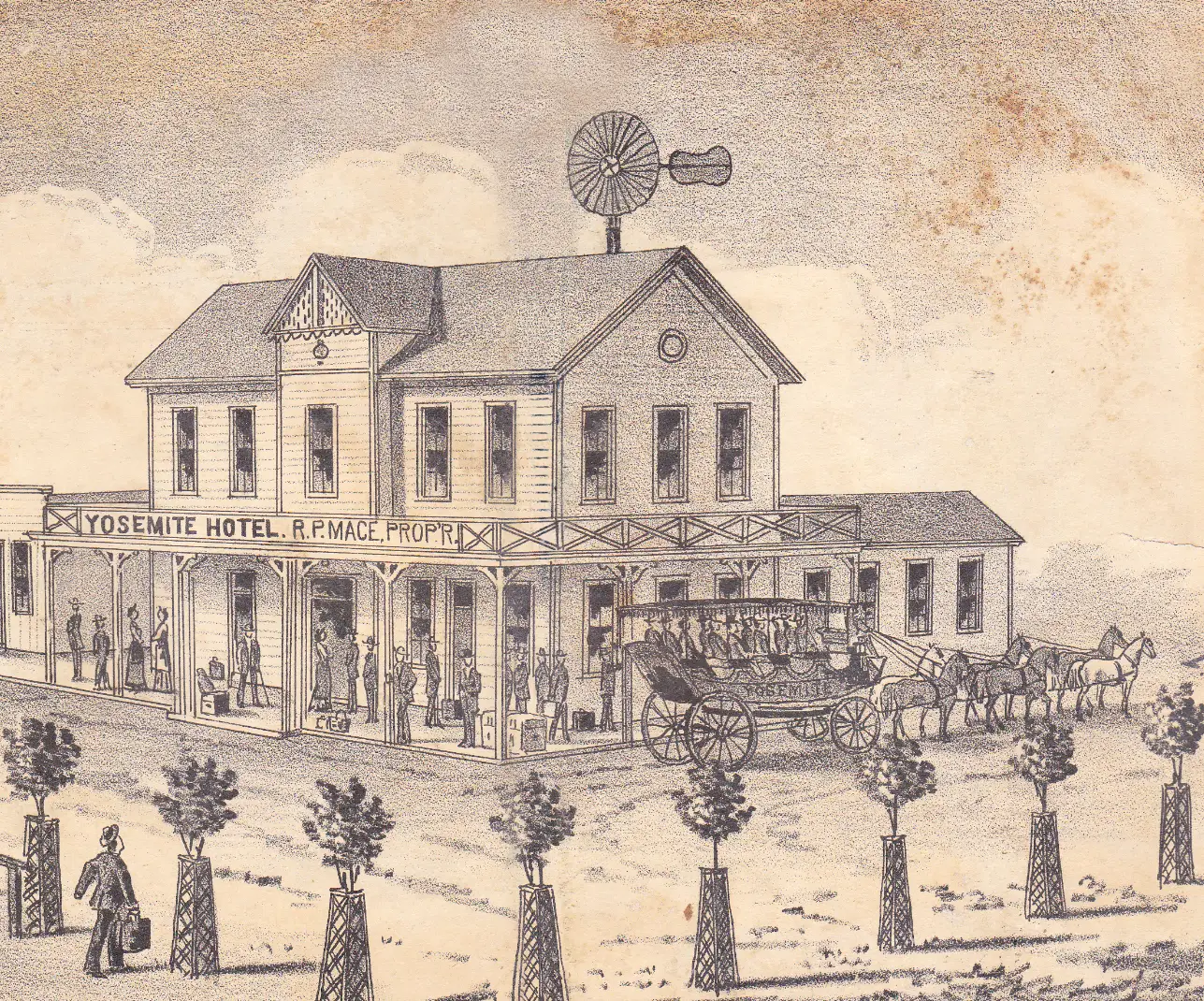The doctor came to Madera in April 1877, when it was just six months old. The young, upstart village then consisted of 25 buildings, most of them dwellings. It could hardly compare with the mining community of Buchanan, from whence C.E. Brown came, but it had promise. That’s why he decided to remain and become Madera’s first physician.
When Dr. Brown walked up the trail that was to become Yosemite Avenue on that April afternoon, it was already adorned by two saloons. Charley Strivens had a comfortable, neatly finished watering hole, and right next door was Mr. Sanford’s smaller establishment. Dr. Brown decided to put the latter out of business by buying him out.
Once Sanford’s saloon belonged to him, Dr. Brown took every bottle of whiskey in the building and poured the contents out into the street. The dust and dirt of Yosemite Avenue quickly absorbed the liquor in that terrible drought year. Brown turned the former saloon into a pharmacy and proceeded to tend to the ills of Madera’s pioneer residents.
Dr. C.E. Brown had been born in 1848, in the city of Manchester, England. When he was seven years of age, his family moved to Canada. During his youth, he spent most of his time on the family farm.
Upon reaching adulthood, he taught school in both Canada and Michigan and then came West to California to join his brother, F.R. Brown, who was practicing medicine in Plumas County. C.E. Brown prosecuted his medical studies under his brother and then moved back east for his formal training. He attended medical schools in Michigan and Iowa, graduating from Keokuk, Iowa. Then he returned to California where he commenced the practice of medicine in the rip-roaring copper mining town of Buchanan. The year was 1873.
When the first town lots of Madera were put on the market in the Fall of 1876, the event drew Brown’s interest, and six months later he removed his shingle in Buchanan and moved down to Madera.
Dr. Brown was immediately well-liked, especially by Captain Russel Perry Mace, who owned the Yosemite Hotel. The congenial Captain allowed Brown to treat patients at his establishment, thus saving Brown numerous house calls. It was while he was conducting business at Mace’s hotel that the Doctor met Matilda (Tillie) Gilmore, the Captain’s stepdaughter. In 1878 the two were married.
Dr. Brown’s practice was similar to that of most other pioneer physicians. He fought disease; he set bones, and he took care of the unexpected.
For example, in January 1878, T.T. Strombeck while descending a grade in the mountains near Coarse Gold with a six-horse wagon, loaded with lumber, was thrown to the ground by means of the brakes giving way, and both wheels of the wagon passed over his body, breaking his arm in three places below the elbow. In addition, three ribs were torn loose from the spine, breaking one of them. The entire length of the spine was fearfully lacerated and some vertebrae were broken. Strombeck was removed to Capt. Mace’s Hotel in Madera where he gradually recovered under the watchful eye of Madera’s first physician.
There were times when Dr. Brown had to violate the normally hard and fast rule of not becoming his own physician since there were no others in town. In August 1878, while calling on a patient, the Doctor’s team became frightened and ran away. In his attempt to bring the horses under control, Brown was thrown out and suffered serious internal injuries. For the next few months, he was forced to follow the dictum, “Physician, heal thyself.”
For five years, Dr. C.E. Brown tended early residents. He and Tillie became pillars of the society that existed in pioneer Madera. He was held in high esteem by all of Madera’s first families, and then came that fateful night of March 30, 1882.
On that evening he came down with a “congestive chill.” Two Fresno physicians were called in, and his brother, Dr. F.R. Brown, then of Shasta County, arrived on Sunday evening, but all was to no avail, the malady — acute pneumonia — took rapid strides, and at 9:30 p.m. of the fourth of April he died at the ripe old age of 34.
Dr. Brown’s obituary noted that he “had a large practice and by his universal success in the profession had won the confidence of all who had tried his skill as a physician. He will be sadly missed by his friends and acquaintances, for he had a wellspring of life and good humor that was always ready to disperse gloomy feelings in those around him. The loss that his wife, parents, brothers, and sisters have sustained can be realized only by those who stood close to him in those relations and understood the generous and affectionate heart that was ever planning some good or some pleasure for those he loved.”
They carried Dr. Brown out to the newly created Madera cemetery (now Arbor Vitae) and committed him to the earth. That’s where his mortal remains can be found today, in the company of his wife, Tillie, and a number of Madera pioneers. He lies beneath an impressive marker, a sure sign of the universal esteem with which Madera’s first physician was held. What a tale this tombstone could tell.
Originally published in the Madera Tribune




